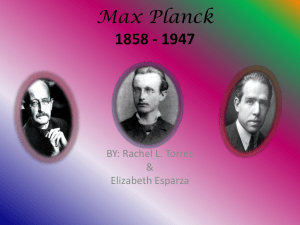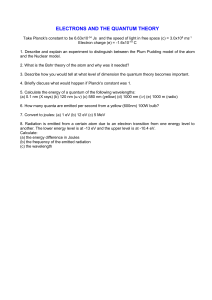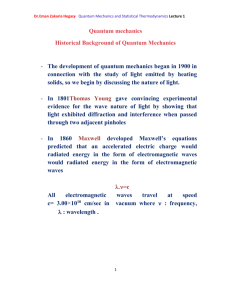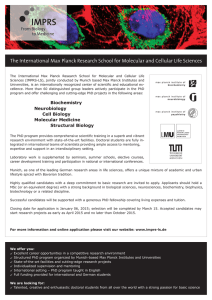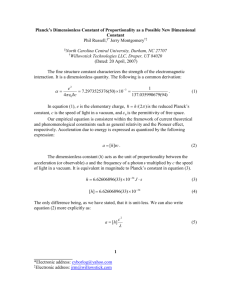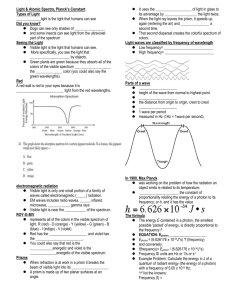early quantum theory genesis in the intertheoretic context.
advertisement
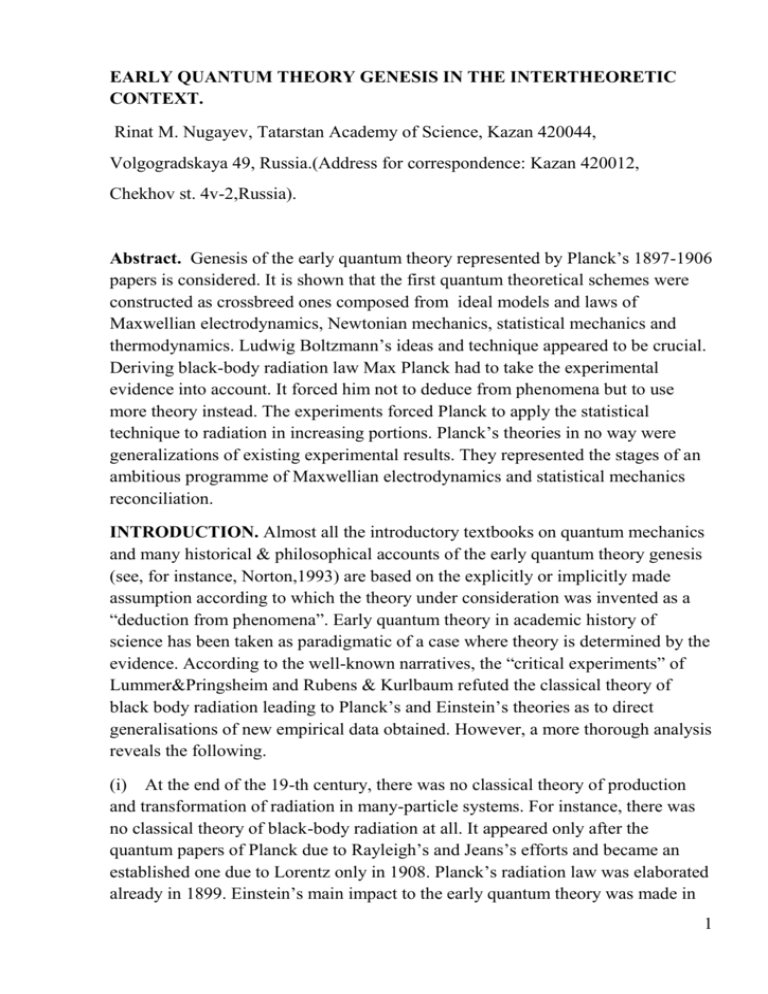
EARLY QUANTUM THEORY GENESIS IN THE INTERTHEORETIC CONTEXT. Rinat M. Nugayev, Tatarstan Academy of Science, Kazan 420044, Volgogradskaya 49, Russia.(Address for correspondence: Kazan 420012, Chekhov st. 4v-2,Russia). Abstract. Genesis of the early quantum theory represented by Planck’s 1897-1906 papers is considered. It is shown that the first quantum theoretical schemes were constructed as crossbreed ones composed from ideal models and laws of Maxwellian electrodynamics, Newtonian mechanics, statistical mechanics and thermodynamics. Ludwig Boltzmann’s ideas and technique appeared to be crucial. Deriving black-body radiation law Max Planck had to take the experimental evidence into account. It forced him not to deduce from phenomena but to use more theory instead. The experiments forced Planck to apply the statistical technique to radiation in increasing portions. Planck’s theories in no way were generalizations of existing experimental results. They represented the stages of an ambitious programme of Maxwellian electrodynamics and statistical mechanics reconciliation. INTRODUCTION. Almost all the introductory textbooks on quantum mechanics and many historical & philosophical accounts of the early quantum theory genesis (see, for instance, Norton,1993) are based on the explicitly or implicitly made assumption according to which the theory under consideration was invented as a “deduction from phenomena”. Early quantum theory in academic history of science has been taken as paradigmatic of a case where theory is determined by the evidence. According to the well-known narratives, the “critical experiments” of Lummer&Pringsheim and Rubens & Kurlbaum refuted the classical theory of black body radiation leading to Planck’s and Einstein’s theories as to direct generalisations of new empirical data obtained. However, a more thorough analysis reveals the following. (i) At the end of the 19-th century, there was no classical theory of production and transformation of radiation in many-particle systems. For instance, there was no classical theory of black-body radiation at all. It appeared only after the quantum papers of Planck due to Rayleigh’s and Jeans’s efforts and became an established one due to Lorentz only in 1908. Planck’s radiation law was elaborated already in 1899. Einstein’s main impact to the early quantum theory was made in 1 1905 - 1907. Wien’s classical formula describing the dependence of density of blackbody radiation upon its frequency was a phenomenological one obtained in an ad hoc way. It was to be corrected by the works of Max Planck. The latter applied the joint apparatus of electrodynamics, thermodynamics and statistics to rederive it as a theoretical law and to improve Wien’s half-phenomenological results. (ii) On the other hand, Einstein’s efforts to introduce light quanta were not the attempts to save the phenomena and to explain the “hard facts” that could not be explained by classical theories. Although one often reads the statement that in 1905 Einstein was concerned with an explanation of the photoelectric effect, the study of his 1905a (“light quanta”) paper reveals that this was not the case. The measurements of the effect at that time were not sufficiently accurate to point without any doubt to a violation of classical behaviour (Ter Haar,1967). Einstein worried not so much by the evidence dealing with photoeffect and appealed to fluorescence, photoelectricity and photoionization data only as to indirect evidence in favour of his light quantum thesis. (iii) History of the early quantum theory in recent literature was shown to be not an unproblematic, paradigmatic case where theory is unequivocally determined by the evidence. On the contrary, there is a certain portion of theoretical indetermination there. At first, in 1969-1984 Timothy H. Boyer (see, for instance, Boyer 1975,1984) convincingly demonstrated that most of the early and the old quantum theories’ phenomena (beginning with Planck’s radiation law) can be explained in a strictly classical way in his “stochastic electrodynamics”. The presence of random classical electromagnetic zero-point radiation with a Lorentz-invariant spectrum modifies the ideas of classical electron theory so as to provide three classical derivations of Planck’s spectrum. Secondly, Robert Hudson (1997) showed that, contrary to Einstein, Jeans and Poincare (in a company with Klein, Kuhn and Norton), the Rayleigh-Jeans law is not a law one should expect from a classical physicist since the derivation of this law requires an ad hoc hypothesis on equipartition. Many classical physicists (like Boltzmann) did not ,in fact, accept the hypothesis and classical equipartition theorem. Hence the aim of the paper is to present a rational reconstruction of the early quantum theory genesis explaining the peculiarities (i)-(iii) away by exploiting the theory-change model presented in my book (Nugayev,1999). The aim of the paper is to make a step towards a complete description of the Quantum Revolution and to 2 bring some light on the intertheoretic relations between the early quantum theory and other physical theories of the day, stressing their role in its genesis and acceptance. In this piece of work, I have nothing to say on the critical experiments, refutations and other empiricist gobble - gooking except that these notions are unnecessary in describing the Quantum Revolution. On the other hand, the relativist notions of “crisis”, “paradigm-shift”, “gestalt switch”, “incommensurability”, etc. appear to be unnecessary . The real origin of the revolution lied not in a clash of classical theories with “facts” but in the series of clashes of 3 classical theories between each other. Experimental evidence played auxiliary role. The genuine innovations occurred as a result of the efforts to reconcile the three research programmes of classical physics. A few words should be said on the historiographical basis of the present work. Though not completely, it is based on Thomas Kuhn’s 1978 book and papers on quantum discontinuity, not to forget Rene Dugas’s (1959), Martin Klein’s (1962,1966), Max Jammer’s (1966), Stephen Brush’s (1967) and Hans Kangro’s (1970) impacts. I am not quarrelling with the facts presented in their accounts . I am discontent with some interpretations of them and especially with the selection procedures picking up the essential facts and disregarding the unimportant ones. (For instance , I disagree with Kuhn’s underestimation of Planck’s impact into early quantum theory). In full accord with Imre Lakatos’s (1971) recipes my rational reconstruction presents a selection of facts governed by theory-change model lying in the heart of the matter. PART ONE. MAX PLANCK’S BLACK-BODY THEORY. At the end of the 19-th century, three research programmes were to interact consequentially in Max Planck’s work: thermodynamics, electromagnetic theory and statistical mechanics. Before 1900 , he has made valuable contributions to all three but their weight diminished in his creativity from thermodynamics through Maxwell’s theory to Boltzmann’s approach. Thermodynamics was a paragon of scientific theory for him. Planck’s work in it was well-known and highly appreciated before he first turned, with doubts and hesitations, to electrodynamics. Statistical mechanics entered Planck’s research later and against much resistance. For him the role of electrodynamics and statistical mechanics initially was instrumental. Maxwell’s equations and Boltzmann’s technique provided conceptual tools to solve the problem of irreversibility first and then the problem of blackbody radiation. 3 It should be pointed out from the very beginning that “classical theory of blackbody radiation” before Planck’s efforts did not exist at all. What did exist? – A plenty of phenomenological and half-empirical laws obtained either at the expense of generalisation of empirical data or either due to physically wild and ad hoc assumptions inserted into the body of knowledge. For instance, in 1879 Josef Stefan, as an extrapolation from preliminary experiments, showed that the dependence of the black-body radiation density u upon temperature T is described by Then Langley, W.Michelson, H.Weber, F.Paschen had produced expressions for blackeriments, until W. Wien theoretical considerations in a highly speculative way. For Wien (1896) a heated gas served as the source of blackbody radiation. Following the line of thought of Russian physicist Vladimir Michelson, Wilhelm Wien showed that ,in the gas, number of molecules with velocities in the range between v and v + dv is, by Maxwell’s distribution law, was proportional to v2 exp(one makes the extremely unnatural assumption that both the frequency and the intensity of the radiation from a given molecule are functions only of that molecule’s velocity, then the distribution of radiation must obey the equation After determining F and f, Wien arrived at the expression (in modern notation, using more exact values for the constants) Of course as a product of theory, the Wien distribution law had little authority until Planck rederived it by a remarkably different route in 1899. His efforts transformed an empirical law obtained in a dubious way into a theoretical one, with the domain of validity established: were the first effort to construct genuine theory of black-body radiation, i.e. to thermodynamics and electrodynamics as opposed to phenomenological efforts to guess the right expression through experimental results. Naturally Planck met many obstacles on this way, deriving partial theoretical laws, comparing them with experimental results, correcting the laws, etc. 4 Planck was a theoretician par excellence with thermodynamics taken a paragon of scientific theory. In Planck’s times thermodynamics became an established, carefully thought and composed, respectable theory with a plenty of practical applications. When he came to a conclusion that thermodynamics is insufficient, he turned to Maxwellian electrodynamics – young and dubious at that times, whose empirical corroboration had just begun. However, Planck, in his quest for irreversibility, had to insert resistanceless vibrating resonators into his first theoretical scheme – tiny oscillating currents governed by Maxwell’s equations. Planck’s oscillators had nothing to do with experiments. They had nothing to do with molecules, atoms or even electrons being a theoretical device for establishing thermodynamical equilibrium between matter and radiation. In 1897 Planck published the first paper of a five-part series entitled “On Irreversible Radiation Processes” (Planck,1897a). In all the five papers (Planck,1897, a,b,c,1898,1899), as well as in the major article, which recapitulated their results for the “Annalen der Physik” (Planck, 1900b), he investigated the properties of an ideal model consisting of a system of resonators interacting with an electromagnetic field. However, after he had read his first paper to the Academy, a critique by Boltzmann was presented to the same audience. Boltzmann argued that, though Planck’s expressions for resonator absorption and emission were correct, the programme for which they were designed should necessarily fail. Both Maxwell’s equations and the boundary conditions on their solution are invariant under time reversal. When the application of Maxwell’s equations turned out to be insufficient, Planck had to use statistics – quite unwillingly, step by step, under the constant pressure of experimental results. The following story is of particular importance here (Dugas,1959; see also De Broglie, 1962, p.139). Planck, who intended to broaden the domain of validity of statistical thermodynamics, developed (with a help of classical continuous notions) thermodynamics of electromagnetic radiation and tried to introduce entropy of radiation by analogy with its energy. Being an admirer of famous Ludwig Boltzmann, Max Planck informed the founder of statistical mechanics about the investigations done, and presented one of his papers to Boltzmann’s judgement. However, Boltzmann answered that Planck would never be able to create a correct theory of statistical thermodynamics of radiation without introducing previously unknown element of discontinuity into processes of radiation. Even in 1872, 28 years before Planck’s 1900b paper, Boltzmann in his paper “Further investigations of thermal equilibrium between gas molecules” applied the 5 notions of discrete energy to the exchange processes. Deriving the second law of thermodynamics from a statistical point of view, Boltzmann arrived at energy atoms in the processes of molecules’ interactions. The notion of the finite energy amounts that can be exchanged for colliding molecules leads Boltzmann to calculations of the number of collisions with the help of combinatorials. However, due to the dominant worldview, Boltzmann considered the notions of energy quanta just as an auxiliary mathematical device. “Boltzmann’s heritage” was controversial and debatable. At first Planck tried to get through by using an electromagnetic analogue of Boltzmann’s Htheorem, and when it appeared to be insufficient, he had to apply the probability calculus and the combinatorial definition of entropy which he whole-heartedly disliked most of all. So, “by mid-winter 1897-98, at the latest, Planck was studying Boltzmann’s version of the second law with care, was exploiting suggestions he found there, and had abandoned or all but abandoned his resistance to Boltzmann’s approach. Unfortunately for historians, he did not explicitly acknowledge his change of mind for almost two years, a delay that has reinforced the almost universal impression that his conversion to a statistical viewpoint was intimately associated with his introduction of a quantum hypothesis at the end of 1900” (Kuhn, 1978, p.78). However, one has direct evidence of Planck after the events. In a letter to Robert Wood (Planck, 1931) he confessed that “Boltzmann explained the existence of thermodynamical equilibrium through statistical equilibrium; if his considerations are applied to equilibrium between matter and radiation, one arrives at the conclusion that the transformation of all the energy into radiation [demanded by classical physics] can be avoided by the supposition that energy should exist from the very beginning in some discrete portions”. Planck remembered later that all his life, either in publications or correspondence, Boltzmann was cool with him. Only in his last years, when Planck told him about the atomistic justification of his radiation law, Boltzmann changed his attitude radically and became exceedingly friendly to Planck. By the beginning of 1900, only one aspect of Boltzmann’s treatment of irreversibility was still absent from Planck’s approach, the use of combinatorials, and by the end of the year, Planck had embraced that aspect, too. What led him to do so was no longer the problem of irreversibility. It was rather the search for a radiation law that could pass the test of new, more refined experiments. The single obvious imperfection of the derivation of the Wien distribution law, that Planck submitted to the “Annalen der Physik” in November 1899, was the lack of a uniqueness proof for the function he had defined as oscillator entropy. 6 Pointing on their measurements of the frequency distribution of radiation from a new piece of experimental apparatus, the first laboratory black cavity, O. Lummer and E. Pringsheim proposed a new formula for the blackbody radiation that deviated from Wien’s law. Planck eliminated the difficulty in a paper submitted for publication in February 1900. In that paper he claimed to have derived, rather than defined, oscillator entropy for the first time, supporting Wien’s law again. But experiment proved stubborn. In a paper, reported to the Physics Section of the Naturforscherversammlung on the 18 September 1900, Lummer and Pringsheim declared that the Wien-Planck distribution law did not represent their measurements on black radiation in the low frequency region. In this range, achieved only with the aid of recently developed techniques, the discrepancies between experiment and theory were near 50% and could not be due to experimental errors. The evidence was entirely convincing, but Planck was prepared to meet it now. In a paper presented to the Physical Society on 19 October he referred to the proof of the Wien law he had submitted to the “Annalen der Physik” in March, and at once pointed its shortcoming. The entropy of n oscillators must, he stated, depend not simply on their total energy , as was supposed, but on the energy U of a unsophisticated and should be exchanged for a more sophisticated form. Planck had found an equation that “is the simplest by far of all the expressions which yield S as a logarithmic function of U (a condition which probability theory suggests) and which besides coincides with the Wien law for small values of U”. If the equation for S is regarded as the first term (n of -1, his new form follows directly by the addition of a term proportional to U2. l – 1. This radiation formula, Planck stated, “so far as I can see by quick inspection, represents the hitherto published observational data just as satisfactorily as the best previously proposed distribution function…I therefore feel justified in directing attention to this new formula, which, from the standpoint of electromagnetic radiation theory, I take to be the simplest excepting Wien’s”. New measurements quickly showed the last equation to be superior to all the other distribution laws. But Planck had to find the route to the formula that was less ad hoc. “On the exact day”, Planck says, “when I first formulated this law, I began to devote myself to the task of investing it with a real physical meaning, and that issue led me of itself to the consideration of the relationship between entropy 7 and probability, and thus to Boltzmann’s line of thought”(Planck,1909). As Thomas Kuhn correctly pointed out, those remarks have regularly been read as recording Planck’s initial conversion from a phenomenological to statistical thermodynamics. But that turn-about had occurred at least a year, and more probably three years, before. When Planck referred to “ the relation between entropy and probability”, he did not have in mind the statistical approach in general but only, as his words suggested, Boltzmann’s combinatorial definition of entropy. Planck, who must have discovered the combinatorial definition in Boltzmann’s “Gas Theory”, appears to have been the first man to acknowledge even its existence. Planck’s initial derivation of the Wien law contained an internal contradiction. The n resonators he considered were required to be independent, but his argument depended on supposing that their total energy Un was distributed equally among them. An improved argument would consider the various ways in which that energy might be divided between resonators as Boltzmann, in his combinatorial arguments, had divided the total energy of a gas among its molecules. Expression for Planck’s distribution – 1 can be integration one gets Planck should have been encouraged by its clear resemblance to Boltzmann’s expression for the logarithmic relation between entropy and probability. Yet the equation applies only to a single resonator with energy U in equilibrium with a radiation field and is not suitable for interpretation in probabilistic terms. S with their radiation field. Their total entropy should be equal to NS, and their total energy should be equal to NU. If combinatorials are to be introduced, the total energy must be su To obtain an expression involving only integers, the size of the energy and P, to (N+P-1)!/ (N-1)!P! But that expression is the standard expression for the number of ways in which P indistinguishable elements can be distributed over N distinguishable boxes. The first stages in Planck's utilisation of Boltzmann's 8 relation between entropy and probability were completed. But the problem still remained. The combinatorial expression discovered by working backwards from Planck's distribution law was decidedly different from the one Boltzmann had developed in deriving the equilibrium distribution of gas molecules. Hence Planck had to show that it is proportional to the probability appropriate to equilibrium radiation. Planck’s problem was to compute the entropy of a particular distribution of the total energy E over N resonators Then he had to discover its maximum with respect to variation of the distribution of the total energy over frequency. To compute the entropy of an arbitrary distribution Planck had to introduce combinatorials and hence he followed Boltzmann in subdividing the energy continuum into elements of finite size. “We must now give the distribution of energy over the separate resonators of each group, first of all the considered to be a continuously divisible quantity, this distribution is possible in infinite many ways. We consider, however, – this is the most essential point in the whole calculation– E to be composed of a very definite number of equal parts and use there the constant of nature h = 6,55 x 10-27 (erg x sec). This constant distributed over the N resonators” (Planck, 1900b; translated by Ter Haar,1967,p.83). Planck next defines a “complexion” (an expression, he stresses, “used by Boltzmann for a similar concept”) as a particular specification of the set of in the set of N. The total number of possible complexions is R. To find the equilibrium distribution one has to maximise R or log R by varying the energies at the various frequencies. Straightforward manipulations show that the entropy (log R) will have a maximum if –1 Corresponding distribution for th It should be specially pointed out that both in his original derivation papers and far more clearly, in «Lectures» (1906), Planck's radiation theory is incompatible with the quantization of the resonator energy. That theory only require fixing the size of the small intervals into which the energy continuum is subdivided for purposes of combinatorial computation. In Planck's theory, resonator emission and absorption are governed in full by Maxwell's equations. Planck did repeate 9 similar restriction on the energy of an individual resonator, which may vary continuously. Thus, though Planck constantly turned to the experimental results, the role of the experiment should not be over-rated. Black-body experiments played the role of the factor, that forced Planck to apply statistics in the growing rates. In the lack of experimental data Planck would not use Boltzmann's combinatorials in full rate since he did dislike them whole-heartedly. The latter was based on introducing distinctive and dubious hypotheses that Planck, an admirer of classical thermodynamics, tried to avoid. One cannot declare that Planck's distribution law was a generalisation of experimental results. On the contrary, Planck's route to it was from top to bottom. Of course, he had to take the experimental evidence into account bit it forced him not to «deduce from phenomena» but to use more theory instead. As one of the first pure theoreticians in physics, a leader of German theoretical physics, Planck can in no ways be described as a boy lucky to find a law the significance of which he did not understand. As a professional theoretician, Planck was extremely sensitive to the importance of the problem he tried to solve and to the emergence of taking it in the intertheoretic context. He clearly understood the origin of the problem lying in the deep contradictions between mechanics, statistics, electrodynamics and thermodynamics. “Nowadays, (the following) two significant fields are set against each other: mechanics and electrodynamics, or, as they are sometimes called, the physics of matter and the physics of ether. The first includes acoustics, heat and chemical processes; the second includes magnetism, optics and radiant heat. Is this subdivision final? I do not think so, mostly because neither of these fields of investigation is divided by strict and firm lines. For instance, does radiant heat belong to mechanics or to electrodynamics? Or to which field must the law of electron movement be attributed? At first sight one can state that it should be attributed to electrodynamics since ponderable matter plays no role for electrons. Let us direct our attention on the movement of electrons in metals. Studying Lorentz’s works one can arrive at a conclusion that the laws of such motions are more appropriate for kinetic theory of gases than to electrodynamics ”(Planck,1910,p.616). And more obviously in 1906 “Lectures on Heat Radiation” Planck uses the same arguments as Einstein in 1905a paper: 10 “Introduction of probabilistic notions into electromagnetic theory of heat radiation means the introduction of entirely new element that is align to the fundamentals of electrodynamics. Hence from the very beginning the principal question occurs on the justification and necessity of such notions. At first sight, one can easily come to a conclusion that theory of probability has no place in theory of pure electrodynamics. Indeed, electromagnetic field equations together with initial and boundary conditions are known to determine the duration of electromagnetic process in time. Hence all the considerations disconnected with field equations seem to be substantially unjustified and at least not necessary. Either they lead to the same results given by the main equations of electrodynamics, – and they are needless, -or either they lead to other results and hence they are false. In spite of the unsolvable dilemma, there is a gap in the above considerations. Indeed, trying to get deeper into the heart of the matter, one can see that both “initial and boundary conditions” and “time duration” of some process, as we understand them in electrodynamics, are not the same in thermodynamics. To understand the problem situation better one has to turn to a concrete example considered in the last chapter – to hohlraum radiation that is homogeneous in all directions. From thermodynamical point of view, the state of radiation is entirely insufficient; from this point of view to determine the state one has to determine each of six magnetic and electric components of the field in all the space points…” (Planck,1906,p.105). It was the fact of origin of early quantum theory from the clash between classical electrodynamics and statistical mechanics that was indicated by one of the leading Russian theorists of the 20-th century beginning: “But the most curious thing is that the quantum idea should be born half a century ago, when the kinetic theory of the matter was created. This idea is intimately connected with molecular structure of matter and is a specific reflection of this structure”(Goldgammer, 1911). The works of Michelson, Wien, Boltzmann, Planck and Einstein were the stages of penetration of statistical methods and concepts into radiation theory, the stages of considering the electromagnetic field from a statistical point of view (Bucklayev,1957). In the sense, one can speak of the Boltzmann-Wien-Planck synthetic programme of reconciling electrodynamics and statistical mechanics. (See more on synthetic and reductionist research programmes in Nugayev, 1999).Subsequent versions of the programme are characterised by ad hoc and non 11 ad hoc reactions to the experimental results.The programme provided constant empirically progressive problemshift in comparison to its rival – the reductionist programme of James Jeans. Its first ideal model was presented in the paper of Vladimir Michelson. He tried to explain an analogy between the form of the experimental curve describing the frequency dependence of black-body radiation energy and Maxwell's distribution curve in theory of gases. Though Wien elaborated Michelson's ideal model , the hypotheses that provided the shift from the initial version of the programme to the second one, appeared to be so ad hoc, that in fact the first real theoretical derivation of the black-body radiation spectrum in the high-frequency limit was given by Max Planck. However, reconciliation of these theories on the crossbred-level forced to changes in the foundations of the theories in future. In particular, inconsistency in the energy distribution between oscillators further brought to individual oscillator energy quantization. The irrefutable hard core of the programme was outlined in the given long quotation (Planck,1906) and consisted of three constructively-independent basic theories: electrodynamics, thermodynamics and statistical mechanics. The positive heuristic, as opposed to Jeans's programme, consisted in the assumption that the electromagnetic radiation in some aspects shows particular properties and hence can be described by the laws and principles of statistical mechanics. The protecting belt of auxiliary hypotheses was constructed by a system of models M1, M2, …,Mk that gave more and more exact «pictures of reality». Some of the resulting theories were ad hoc, but were later exchanged for the better ones that corrected their faults. For instance, some of Planck's theories were ad hoc, and his distribution law was obtained in an ad hoc manner first but was corrected soon. The hard core of Jeans's reductionist programme consisted of classical electrodynamics. The positive heuristic of the programme consisted in the assumption that the physical situations studied in black-body experiments are not cases of equilibrium at all. Hence the negative heuristic tells one that thermodynamics and statistical mechanics are inapplicable in these cases. Protecting belt of the programme was able to avoid the ultraviolet catastrophe : millions of years might be required to transmit energy from the lower to higher modes of vibration. A genuine equilibrium might never be achieved. Hence Maxwell-Boltzmann equipartition theorem is inapplicable. The history of the competition of the synthetic programme with its rival, especially with the reductionist programme of Jeans, is fascinating in itself. We will not pay much attention to it here. The main trouble with Jeans's programme was that not only experiments on the distribution of radiant energy became 12 inexplicable. By denying that these experiments dealt with equilibrium situations, Jeans also denied the relevance of thermodynamic arguments to them. New derivations would have to be found for Kirchhoff's law, the Stefan-Boltzmann law, and the Wien displacement law. Though Jeans provided stimulating and skillful explanation of the Stefan-Boltzmann law in his programme, it was quickly forced out by the development of the quantum programme with its successes in the domain of specific heats first of all. Contrary to Jeans, quantum synthetic programme provided the construction of the crossbreed objects constructed from the basic objects of electrodynamics, thermodynamics and statistical mechanics. All the models constructed within the synthetic programme under consideration were crossbred ones but in different extents. They became more and more crossbred under the influence of experiments. between statistical mechanics and electrodynamics. Real elimination of the crosscontradiction consisted in the creation of quantum electrodynamics, in construction of quantum theory of radiation that took electromagnetic particles as Boltzmann’s molecules that can gain energy under collisions with usual molecules and resonators (Landau,1958). The other man who noticed it was Albert Einstein. REFERENCES Bohr Niels (1913): On the Constitution of Atoms and Molecules. Philosophical Magazine, vol.26,pp.1-25,476-502,857-875. Boyer Timothy (1975) : Random electrodynamics: The theory of classical electrodynamics with classical electromagnetic zero-point radiation. The Physical Review, vol. 11, number 4,pp.790-808. Boyer Timothy (1984) : Derivation of the black-body radiation spectrum from the equivalence principle in classical physics with classical electromagnetic zero-point radiation. The Physical Review, D, vol.29, number 6, pp.1096-1097. Brush Stephen G. (1967) : Foundations of Statistical Mechanics, 1845-1915. Archive for History of Exact Sciences, vol. 4, pp.145-183. 13 Bucklayev V.G. (1957) : L. Boltzmann and Planck’s quantum hypothesis. Voprosi istorii yestestvoznaniya i techniki (Problems of History of Natural Sciences and Techniques), vol.4, pp.167-168 (in Russian). De Broglie Louis (1962) : Mysterious constant h - Max Planck’s celebrated discovery. - In: Following the Paths of Science. Moscow, Izdatelstvo Inostrannoy Literaturi (Foreign Literature Publishing House),pp.139-146 (in Russian). Dugas Rene (1959): La theorie physique au sens de Boltzmann et ses prolongements modernes. Paris, Editions de Griffon. Goldgammer D.A.(1911): New Ideas in Modern Physics. - Fizicheskoye Obozreniye (Review of Physics), vol.12,numbers 1-2,pp.1-35,76-155 (in Russian). Goldgammer D.A.(1912a): On the Hypothesis of Light Quantities. JRPCS (The Journal of Russian Physico-Chemical Society), Physics Division, vol.18,part 7(in Russian). Goldgammer D.A.(1912b): Time. Space. Aether. - JRPCS, part 5,pp.173189 (in Russian). Goldgammer D.A.(1923): The World Invisible to an Eye. Berlin, RSFSR State Publishing House (in Russian). Hoyer Ulrich (1980) : Von Boltzmann zu Planck. Archive for History of Exact Sciences, vol.23, number 1,pp.47-86. Jammer Max (1966) : The Conceptual Development of Quantum Mechanics. New York, Mc Graw-Hill. Jeans James (1905): On the Partition of Energy between Matter and Aether. Philosophical Magazine, vol. 10, pp. 91-98. Kangro Hans (1970) : Vorgeschichte des Planckschen Strahlungsgesetzes. Wiesbaden: Steiner. Translated as “ History of Planck’s Radiation Law. London: Taylor and Francis, 1976. Klein Martin J. (1962) : Max Planck and the beginning of the quantum theory. Archive for History of Exact Science, vol.1, number 5, pp.459-479. 14 Klein Martin J. (1966) : Thermodynamics and quanta in Planck’s work. Physics Today, vol.19, number 11, pp. 23-28. Kobzarev Igor Yu.(1979): A. Einstein, M. Planck and atomic theory. – Priroda (Nature), number 3,pp.8-26 (in Russian). Kuhn T.S.(1978) :Black-Body Theory and Quantum Discontinuity,18941912. Oxford and New York. Kuhn Thomas S.(1980): The Halt and the Blind: Philosophy and History of Science.- The British Journal for the Philosophy of Science,vol.31,pp.181-192. Landau Lev D.(1958):The Quantum Theory from Max Planck up to now.In: Map Planck.1858-1958. Moscow, USSR Academy of Science Publishing House,pp.93-98 (in Russian). Lakatos Imre (1970): Falsification and the Methodology of Scientific Research Programmes. - In: I.Lakatos & A.Musgrave (eds.) Criticism and the Growth of Knowledge, CUP,pp.91-195. Lakatos Imre (1971): History of Science and its Rational Reconstructions. In: R.C.Buck & R.S.Cohen (eds.). Boston Studies in the Philosophy of Science,vol.8.Reprinted in C.Howson(ed.)Method and Appraisal in the Physical Sciences, 1976,CUP. Larmor J.(1909): On the Statistical and Thermodynamical Relations of Radiant Energy. - Proceedings of the Royal Society,A560,December, pp.82-95. Norton John (1993): The Determination of Theory by Evidence: The Case for Quantum Discontinuity, 1900-1915. Synthese, vol. 97, pp.1-31. Nugayev Rinat (1999) : Reconstruction Of Mature Theory Change. A Theory-Change Model. Peter Lang: Frankfurt am Main. Planck Max (1897a): Uber irreversible Strahlungsvorgange. Erste Mitteilung. Berl. Ber., pp.57-68. Planck Max (1897b): Uber irreversible Strahlungsvorgange. Zweite Mitteilung. Berl. Ber., pp.715-717. Planck Max (1897c): Uber irreversible Strahlungsvorgange. Dritte Mitteilung. Berl. Ber., pp.1122-1145. 15 Planck Max (1898): Uber irreversible Strahlungsvorgange. Vierte Mitteilung. Berl. Ber., pp.57-68. Planck Max (1899): Uber irreversible Strahlungsvorgange. Funfte Mitteilung (Schluss). Berl. Ber., pp.440-480. Planck Max (1900a): Uber irreversible Strahlungsvorgange. Annalen der Physik, vol.1,pp.69-122. Planck Max (1900b): Zur Theorie des Gesetzes der Energieverteilung im Normalspectrum. Verh. D. D. Phys. Ges., vol.2,pp. 237-245. Translated in Ter Haar, 1967. Planck Max (1906a): Vorlesungen uber die Theorie der Warmestrahlung. First edition. Leipzig: J.A.Barth. Planck Max (1910) : Acht Vorlesungen uber theoretische Physik. Leipzig: Hirzel. Originally delivered at Columbia university, 1909, and translated as “Eight Lectures on Theoretical Physics by A.P.Wills, New York, Columbia University Press,1915. Planck Max (1931) : Max Planck and Robert William Wood. Brief 1931. Sources for History of Quantum Physics. Mf. 66,7x. Ter Haar Dirk (1967): The Old Quantum Theory. Oxford, Pergamon Press. Wien Wilhelm (1896) : On the Division of Energy in the Emission-Spectrum of a Black Body, translated in Philosophical Magazine, vol.43, 1897,pp.214-220. 16
